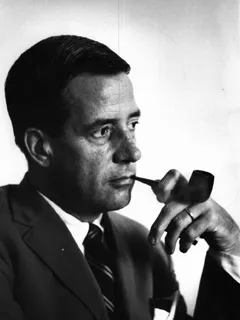Courtney C. Smith
1953–1969

Outspoken against McCarthyism, Courtney C. Smith (1916–1969) led other colleges in attacking the loyalty “disclaimer oath” in the National Defense Education Act. Passed by Congress in 1958, the act required not only a loyalty oath but what came to be known as “the disclaimer affidavit of belief,” which required students who received federal loans to file an affidavit stating “that he does not believe in, and is not a member of and does not support any organization that believes in or teaches, the overthrow of the United States government by force or violence or by any illegal or unconstitutional methods.”
A few months later, Smith denounced the requirement and announced the College’s decision not to participate in the loan program. His statement in part read: “Swarthmore College is opposed to the requiring of any commitment from students as to belief or disbelief as a condition to their receiving loans made in aid of their education. The freedom, privacy, and integrity of individual beliefs is a crucial aspect of America’s constitutional tradition, and these aspects of belief were precisely what the men who wrote the Constitution and the Bill of Rights intended to protect.” Smith also recruited other leaders of higher education to the cause and ultimately testified before Congress for the elimination of the oath.
Smith’s principled stands on this and other issues drew the attention of Time magazine, which wrote in 1964: “When his students invited Communist Gus Hall to speak on campus, President Smith ignored public outcries. Hall spoke. As Smith tells old grads: ‘Your college has guts. There are a lot of colleges that don’t. Be proud of it.’”
Under Smith’s presidency, Swarthmore solidified its reputation as one of the finest small liberal arts colleges in the country. He set in motion a thorough re-evaluation of the College and increased the financial stability of the school. He appealed to the Ford Foundation and alumni to raise faculty salaries and initiated a Faculty Research Fund, which provided support for professors to pursue independent research. He also reduced the number of honors seminars and better incorporated the library into the College’s academic program. Furthermore, Smith oversaw extensive change in the physical campus with the additions of McCabe Library, Sharples Dining Hall, DuPont Science Building, and Worth Health Center.
A Rhodes Scholar like his two predecessors, Smith taught English at Princeton and was serving as head of the American Rhodes Scholarship Committee (directly succeeding former Swarthmore president Frank Aydelotte in the position) when he was selected as the College’s ninth president. Like Nason, Smith also supported the intellectual freedom of the faculty from the start, as expressed in his inaugural address:
“We must see that the headlines do not impugn the loyalty of millions of teachers. … Let’s not assume because government bodies have a clear legal right to investigate ‘Communism’ in the colleges that they are wise to exercise that right. … Let’s limit the investigations to areas where there is a reasonable presumption, as defined by American law, that a law of the land is being violated. Let’s ask ourselves where investigations are to end. …
“But the student can inquire freely only of freely inquiring teachers. As Quakers affirm the validity of the experimental approach to the truth and the right, so the teacher and scholar would say that his approach is experimental.
“We must resist, then, every effort to suppress free thought or free speech, just as the Society of Friends, known first as the ‘Friends of Truth,’ have from their very beginnings 300 years ago resisted every form of suppression and insisted on the importance of questioning the accepted and of trying out new ways of doing things.”
In June 1968, Smith announced he would resign by fall of the next year. At the time, the campus was tense with the social concerns and antiwar sentiments that typified the 1960s. One major concern was negotiations with the Swarthmore African-American Student Society (SASS) to increase the presence of black students on campus.
In January 1969, members of SASS occupied the Admissions Office and demanded that the College take a more active role in the admission and recruitment of African-American students, establish a Black Studies curriculum and Black Cultural Center, and increase the number of black faculty and administrators. On Jan. 16, President Smith died of a heart attack in his office, putting the College in a state of shock and prompting SASS to withdraw immediately. At the time, some blamed SASS’s actions for precipitating the President’s death, while others, including much of the student body, saw it as a sad coincidence. Smith is the only Swarthmore president to die in office.



